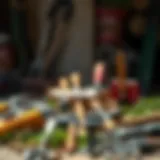Effective Weed Management in Zoysia Grass Lawns
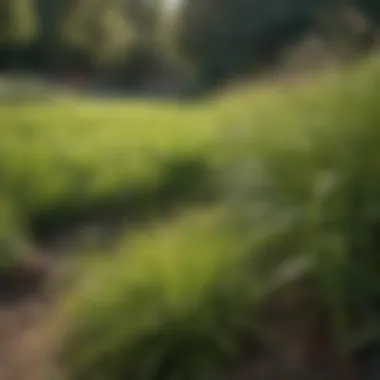

Intro
Managing weeds in Zoysia grass can be a challenge for any lawn care enthusiast. Understanding this issue requires not only knowledge of Zoysia itself but also an awareness of the types of weeds that tend to take root in such grass types. Zoysia grass is loved for its drought resistance and lush appearance, but it can fall victim to the same weed pressures that affect many lawns. The good news is that with a bit of knowledge and strategic planning, you can effectively manage these pesky intruders while maintaining a healthy lawn.
This article will cover vital factors such as the growth patterns of Zoysia grass, the characteristics of common weeds, and various methods to control them. Both old-school practices and modern techniques will be evaluated, giving you a well-rounded view of what you can do to protect your lawn from weed invasion.
Key Concepts and Terminology
Basic Definitions
Before delving into management strategies, it’s essential to clarify some basic terms:
- Zoysia Grass: A dense, heat-tolerant grass type known for its rich green hue. It's commonly found in warmer regions and can handle foot traffic well.
- Weeds: Unwanted plants that compete with desired plants like Zoysia for resources. Common types in Zoysia include crabgrass and dandelions.
- Cultural Practices: Techniques utilized to enhance the growth of desired plants while suppressing weed development.
- Chemical Control: Use of herbicides to target specific weed species while minimizing harm to Zoysia grass.
Historical Context
Historically, the management of grass lawns has seen a plethora of techniques evolve over the years. In the early days of suburban America, manual methods such as pulling weeds and cutting back overgrowth were the norm. Gradually, advancements in chemical formulations made weed control more efficient, but many of these chemicals come with their own set of environmental concerns. As public awareness of sustainability increased, the focus shifted back to incorporating more cultural practices and biological control methods—effectively balancing tradition with innovation.
Recent Innovations and Trends
Technological Advancements
Recent developments in technology have led to new ways to manage weeds effectively. Smart lawn care apps that analyze soil conditions and help schedule appropriate treatments have become quite popular. Additionally, GPS technology is allowing farmers and homeowners alike to apply herbicides more precisely, reducing the risk of overspray and ensuring that only the targeted weeds are affected.
Sustainable Practices
In our current age, sustainability is not just a catchphrase; it’s a necessary approach to landscaping. More people are prioritizing organic and less harmful methods. For instance, using mulch to suppress weed growth can be both effective and environmentally friendly. Additionally, implementing crop rotation and choosing native plant species can create a balanced ecosystem—making it harder for pesky weeds to establish themselves.
Practical Applications and Techniques
Step-by-step Guides
- Understanding Your Lawn: Know your Zoysia’s growth habits and seasonal needs. This knowledge lays the foundation for effective weed management.
- Assessment: Regularly inspect your lawn for initial signs of weeds. Early detection can make control methods far more effective.
- Cultural Methods: Foster healthy Zoysia by ensuring it receives proper nutrients and water. A vigorous lawn has a lower chance of being overrun by weeds.
- Mechanical Control: Mowing at the right height can prevent weed seeds from germinating. Any cut grass should be disposed of properly instead of left on the lawn.
- Chemical Options: If necessary, consider herbicides. Always choose herbicides that target specific weed species without harming Zoysia grass.
"A well-managed lawn doesn’t just look good; it significantly reduces the effort needed for outdoor upkeep."
Case Studies
In one case, a homeowner battling aggressive crabgrass in their Zoysia lawn noted that after implementing a detailed cultural management plan involving aeration, selective mowing, and regular soil testing, their weed problems were cut by nearly fifty percent within just one growing season. This shows how a fundamental approach can act as a game-changer.
In another instance, a community park decided to adopt an integrated pest management approach that combined chemical and non-chemical strategies. By training their staff on the latest best practices for weed identification, they successfully minimized herbicide usage and enhanced the health of the park ecosystem.
By understanding the fundamentals and employing both innovative and tried-and-true methods, enthusiasts can cultivate lush, weed-free Zoysia lawns that are not only beautiful but also sustainable.
Understanding Zoysia Grass
In any discussion about effective lawn care, grasping the nuances of Zoysia grass is paramount. This resilient turfgrass is not just popular for its aesthetic appeal, but also for its ability to withstand varying climatic conditions while requiring less maintenance than many other types of grass. Knowing its specific traits can assist in preventing challenges, especially from invasive weeds.
Characteristics and Growth Patterns
Zoysia grass possesses a reputation for its lush appearance and dense growth. It forms a thick mat, making it challenging for weeds to establish roots. This grass type thrives during warmer months, becoming thick and green, while in colder seasons, it may turn brown and dormant. To illustrate, consider the growth habits of Zoysia: it spreads through underground rhizomes and above-ground stolons, which allows it to fill in bare spots. This growth pattern helps in competing with weeds as the thick carpet of grass crowds them out, leaving little room for invaders.
Interestingly, Zoysia grass has a slower establishment rate than other grasses such as Bermuda or fescue. This slower growth means patience is needed for Zoysia to fully develop but pays off in the long run with a robust lawn that can better resist weed encroachment. It's crucial to remember the native climate preferences of Zoysia, as its thriving ability fluctuates with extreme environmental changes.
Ideal Growing Conditions
For Zoysia grass to truly flourish, certain conditions must be met. First, it thrives best in warm climates, specifically in USDA Zones 6-9. Interestingly, it prefers full sun, making it an ideal choice for areas that receive a lot of sunlight during the day. However, it can tolerate some shade, especially in the temperate areas. The soil type also plays a vital role; well-drained, sandy loam is often optimal for this grass type.
To achieve peak health, soil pH should ideally be between 6.0 and 7.0. Regular soil testing can help ensure those levels remain balanced, promoting optimal nutrient absorption. Overwatering can be detrimental. Zoysia prefers a deep watering approach rather than frequent light watering. This technique encourages deeper root systems, enhancing its resilience against drought conditions and limitation in resources during dry spells.
Ultimately, understanding Zoysia grass’s characteristics and ideal growth conditions is not just about creating a visually appealing lawn. It is about fostering a natural environment that minimizes weed competition and supports healthy grass. With the right knowledge, you can implement informed practices that yield a vibrant and weed-resistant lawn.
The Weed Challenge
The focus on managing weeds in Zoysia grass is not merely an aesthetic pursuit; it addresses fundamental issues related to lawn health and sustainability. Weeds, often seen as unwelcome guests, compete for essential resources such as sunlight, water, and nutrients, which if unchecked, can lead to a decline in Zoysia grass vigor. Understanding the weed challenge is pivotal; it underscores the need for proactive strategies that enhance the resilience of Zoysia while curbing weed proliferation.
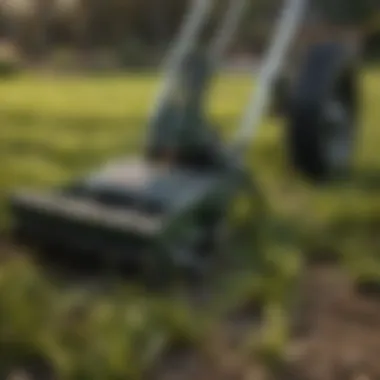

Moreover, integrating effective weed management practices can help restore the natural balance in your lawn ecosystem. With a solid grasp of what weeds can sprout in Zoysia, enthusiasts can formulate comprehensive management plans. This section will delve into the types of common weeds and provide insights on weed identification, building a foundation for successful lawn care.
Common Weeds in Zoysia Grass
Crabgrass
Crabgrass, notorious for its rapid growth, poses a significant challenge in Zoysia grass lawns. This annual weed often sprigs up in disturbed areas, thriving in warmer weather. One notable characteristic of Crabgrass is its sprawling growth habit; it can quickly fill spaces, overcrowding desirable grass. This ability to proliferate is why it consistently ranks as a common nuisance in many lawns.
The unique feature of Crabgrass is its resilience. It often manages to outpace Zoysia during the hotter months, thanks to its capacity to germinate at higher soil temperatures. Yet, this versatility is a double-edged sword. While it can handle drought better than Zoysia, its presence can diminish the lawn’s overall aesthetic and health, leading to bald patches where desirable grass once flourished.
Dandelion
Dandelion is perhaps one of the most recognizable weeds, often seen as a symbol of resilience. With its bright yellow flowers, it may even seem charming. Yet, beneath that façade, Dandelion has a unique ability to tap deep into the soil for moisture and nutrients through its long taproot. This characteristic is crucial in low-nutrient environments, making it a formidable competitor.
Though not inherently harmful, Dandelion can take over if not managed. Its seeds disperse in the wind, creating new plants in various spots, including pathways and gardens. The advantage here is that Dandelions can serve beneficial roles by providing food for pollinators. However, for Zoysia grass enthusiasts, it is vital to maintain control to ensure that Dandelions do not dominate the lawn, thereby stifling the growth and health of Zoysia grass.
Chickweed
Chickweed, an evergreen weed, often springs to life in cooler months. This common weed blends well into Zoysia grass, leading to challenges in identification. It has small, white flowers and a sprawling growth pattern that can make it seem innocuous. The characteristic that sets Chickweed apart is its ability to thrive in moist, shady areas, making it particularly well-suited for lawns that suffer from poor sunlight.
One unique feature of Chickweed is its high growth rate; it can cover your lawn in no time, creating a dense mat. While it doesn't necessarily compete aggressively with established Zoysia grass, it can still disrupt the overall composition of your lawn. A careful approach is necessary, as allowing Chickweed to flourish can lead to a decrease in Zoysia health over time.
Identifying Weed Types
Recognizing the specific types of weeds invading your Zoysia grass is paramount for effective management. Taking the time to distinguish between desirable grass and relentless weeds lays the groundwork for implementing tailored strategies. Factors include growth patterns, leaf shapes, and flowering times which can simplify the identification process.
A hands-on approach often proves beneficial. Regular inspection of your lawn can catch weeds early, preventing them from establishing a stronghold. Consider keeping a journal of weed sightings, noting their characteristics and the areas where they sprout. This practice offers insight into recurring issues and helps inform future weed management strategies.
Cultural Control Methods
Managing weeds in Zoysia grass begins with cultural control methods that can set the foundation for a healthy lawn. These practices emphasize preventative measures rather than reactive ones. It’s important to understand that the primary goal here is to create an environment that’s unfavorable for weeds while promoting the robust growth of Zoysia grass itself. The benefits of cultural controls are numerous—they generally require less time and effort compared to chemical applications and contribute significantly to the soil health.
Proper Mowing Techniques
Adequate Height Settings
One key aspect of maintaining a Zoysia grass lawn is setting the appropriate mowing height. Generally, Zoysia grass thrives when mowed to a height of one and a half to two inches. This height gives it a fighting chance against weeds. Taller grass can shade out weeds, which can’t perform photosynthesis adequately in insufficient light.
The hallmark of setting the right height is that it helps in forming a dense turf. A denser lawn is not only aesthetically pleasing, but it also minimizes weed germination. However, it's essential to avoid cutting too short, as this can stress the grass and leave it vulnerable.
The disadvantage? Some might argue that maintaining this height requires more frequent mowing. Yet, the long-term benefits—like reduced weed incidence—far outweigh this minor inconvenience.
Frequency of Mowing
Frequency of mowing is equally crucial in the cultural management of weeds. Regular mowing maintains desirable height settings, fostering a well-groomed lawn. Ideally, Zoysia grass should be mowed every seven to fourteen days, depending on the growth pace and season. This consistency keeps the grass strong and healthy while disrupting any potential weed establishment.
A unique feature about frequent mowing is that it helps catch emerging weeds early before they can spread their seeds. Some folks think that low maintenance will save time, but in fact, consistent upkeep prevents much bigger problems. Not mowing often enough can lead to a cascade of issues, including overgrown grass that is a haven for weed growth.
Optimal Watering Practices
Watering practices can make or break a Zoysia grass lawn, especially when it comes to managing weeds. Zoysia grass has a deep root system, which allows it to access water below the surface soil. Proper watering is about finding the sweet spot—typically around one inch per week. Overwatering can lead to shallow roots and increased susceptibility to weeds, whereas underwatering can stress the grass and promote weed invasions.
It’s important to water deeply and infrequently. This practice encourages deeper roots in Zoysia grass, making it more resilient to drought and better suited for competing with weeds.
Soil Health Management
Soil Testing
The journey to a vigorous Zoysia grass lawn starts with soil testing. Conduct soil tests at least once a year to gauge nutrient levels and pH. This information is invaluable, as it allows you to tailor your soil management decisions. A healthy soil environment is less likely to support weed proliferation.
Knowing your soil profile helps fine-tune fertilizers and amendments, which keeps Zoysia grass thriving while simultaneously making it difficult for weeds to take root. The ideal pH for Zoysia grass usually hovers around 6.0 to 6.5. If the numbers differ significantly, adjustments will need to be made.
The downside? Soil testing may come with a small cost or require some initial effort. However, these investments pay dividends in long-term lawn health.
Organic Amendments
Integrating organic amendments can significantly enhance soil structure and fertility, fortifying Zoysia grass against weed growth. Think of compost or well-rotted manure—these not only nourish the grass but also cultivate a better ecosystem in the soil, fostering beneficial microbes that displace weed seeds.
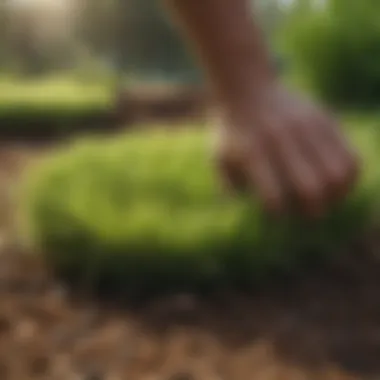

This approach to soil health strengthens the roots while limiting competitions for moisture and nutrients, giving Zoysia a leg up. Organic amendments do take time to work their magic, but the payoff is a lawn that’s lush and resilient. The drawback? Some might find it less straightforward than synthetic alternatives, but the long-term benefits are hard to dispute.
In summary, cultural control methods form the backbone of weed management in Zoysia grass. They foster an environment that not only promotes Zoysia health but actively hinders weed colonization.
Mechanical Control Techniques
Mechanical control techniques play a vital role in the management of weeds in Zoysia grass, offering practical solutions that can be easily implemented. Unlike chemical methods, which may have long-term repercussions on the soil and surrounding ecosystem, mechanical techniques focus on physical interventions. These methods not only help maintain the health of Zoysia grass but also promote sustainable practices that reduce reliance on herbicides. The effectiveness of these techniques lies in their targeted approach, which allows for precise management of weed populations with minimal impact on desirable grass.
Hand Weeding Methods
Hand weeding offers a personal touch and is often regarded as the most straightforward method of weed control. This technique is particularly effective for small infestations of stubborn weeds. By pulling weeds out by their roots, you prevent them from regenerating, which is a huge advantage. When employing this method, it’s crucial to do so when the soil is moist, as this makes it easier to extract the entire root system, minimizing the chances of regrowth. Remember that this can be labor-intensive and may not be feasible for larger areas, but it’s perfect for garden beds or small patches within a Zoysia lawn.
Using Mulch
Using mulch is a tried-and-true method for suppressing weed growth in Zoysia grass. Mulch acts as a barrier, blocking sunlight from reaching the soil and consequently inhibiting weed germination. This not only keeps unwanted weeds at bay but also helps maintain soil moisture and improve overall soil health.
Organic Mulch Options
Organic mulch options are popular among many gardeners for several reasons. Materials such as wood chips, straw, and grass clippings can enrich the soil as they decompose, adding organic matter back into it. This is a key characteristic that makes organic mulch such a valuable choice for Zoysia grass management. Additionally, these materials are commonly available, which means they won't break the bank.
The unique feature of organic mulch is its ability to regulate soil temperature and moisture, creating a more favorable environment for your Zoysia grass. One disadvantage, however, is that organic mulch may need to be replenished regularly to maintain its effectiveness. Ultimately, the benefits outweigh the drawbacks, especially in terms of soil health and weed suppression.
Benefits of Mulching
The benefits of mulching extend beyond just weed control. Mulching can significantly reduce water evaporation from the soil, which means your Zoysia grass will need less frequent watering. This is a major benefit, particularly in areas prone to drought. Another positive aspect of mulching is its ability to prevent soil erosion during heavy rains, which can lead to a more stable lawn over time.
A distinctive feature of mulching is its aesthetic appeal; it can give your landscape a neat and polished look. However, it’s important to apply mulch at the correct depth—typically around three inches—to maximize its advantages. Thick layers can lead to moisture retention issues, which might not suit all types of plants, especially young Zoysia grass.
Aeration and its Benefits
Aeration is often overlooked but is a key technique for promoting a healthy lawn while managing weeds. This method involves perforating the soil with holes to allow air, water, and nutrients to penetrate deeper into the root zone. Aerating Zoysia grass can alleviate compaction, improve drainage, and enhance the overall resilience of the grass against weeds.
The benefits of aeration include better root development, which strengthens the grass’s ability to outcompete weeds. When Zoysia grass is healthy and actively growing, it cultivates a dense turf that leaves little room for weed encroachment. Additionally, regular aeration can also enhance the efficacy of any overseeding you perform, creating patches of Zoysia that are lush and strong.
By incorporating these mechanical control techniques, a holistic approach to weed management in Zoysia grass emerges, making it easier to maintain a healthy lawn. These methods not only yield immediate results but also contribute to the long-term sustainability of both the grass and the soil.
Chemical Control Methods
Chemical control methods play a crucial role in managing weeds in Zoysia grass. They offer an effective solution for tackling more aggressive weeds that can choke out desirable grass species. The methods can lead to quicker results than cultural or mechanical alternatives, making them a popular choice among lawn enthusiasts and professionals alike. However, it's essential to understand how and when to apply these chemicals to minimize any adverse effects on Zoysia grass and the surrounding environment.
Selective Herbicides
Selective herbicides are designed to target specific weed types without harming the Zoysia grass. Their precision makes them a preferred solution when dealing with unwanted vegetation; instead of ruining the ecosystem of your lawn, they focus on problematic invaders. This approach allows healthy grass to thrive while suppressing weeds.
Types of Selective Herbicides
When discussing types of selective herbicides, two categories typically come up: pre-emergent and post-emergent herbicides. Pre-emergent types are applied before weeds germinate, essentially serving as a barrier to growth. In contrast, post-emergent herbicides target weeds that have already sprouted.
The key characteristic of selective herbicides lies in their formulation, which can specifically inhibit growth in target weeds like crabgrass or dandelions while preserving Zoysia grass. This unique feature allows for effective selective control and minimizes the risk of impacting any non-target species in your lawn, making them a favored choice for those who aim for a pristine, healthy lawn with limited collateral damage. However, poorly timed applications can result in ineffective treatments or even harm to the grass, so caution is required.
Application Timing
Application timing is critical to the effectiveness of selective herbicides. For pre-emergent types, the ideal time is in early spring, just as soil temperatures start to rise, signaling the potential germination of many common weeds. On the other hand, post-emergent herbicides work best when applied on actively growing weeds, usually in late spring or early summer.
A key characteristic of application timing is that it directly affects how well the herbicide penetrates targeted weeds. If the timing is off, the herbicide may either miss its target or end up being less effective against established weeds. This precision really underscores its significance. The downside, however, is that this requires a good understanding of local weather patterns and weed life cycles, which can be daunting for some.
Non-selective Herbicides
Non-selective herbicides act broadly and will kill any plant they contact. While they can be effective for initial large-scale weed cleanouts, they require caution. Their impact on both weeds and desirable grass plants means they’re not a go-to for ongoing lawn maintenance.
Usage Considerations
When considering non-selective herbicides, the main aspect to keep in mind is the broad-spectrum nature of these chemicals. Their ability to control virtually all plant life means they require careful handling. For instance, if you plan to treat a large area already filled with Zoysia grass, using a non-selective herbicide might lead to unwanted damage.
A unique feature of these types of herbicides is that they can serve as an effective way to clear out particularly troublesome areas before introducing new grass or plants. However, this advantage comes with the responsibility of ensuring that nearby desirable plants are not impacted. Thus, proper shielding and accurate targeted applications become vital.
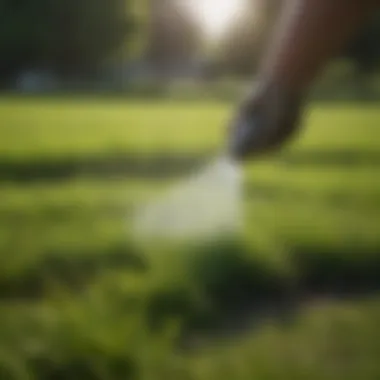

Impact on Soil Health
The impact of non-selective herbicides on soil health is an additional consideration that cannot be overlooked. While they may solve immediate weed problems, using these chemicals can lead to long-term effects on soil biodiversity and health. Many non-selective herbicides can linger in the soil, potentially harming beneficial microorganisms.
The understanding of this impact underscores why non-selective herbicides should be used sparingly and with forethought. Their unique effectiveness does have its benefits, but one must balance this against potential declines in soil health, which could affect future planting and growth potential. Regularly testing soil health after applications can help mitigate some negative effects, ensuring that soil remains vital and productive.
Integrated Weed Management
Integrated weed management (IWM) stands out as a cornerstone in the quest for healthy Zoysia grass lawns. The concept revolves around a multifaceted approach that blends various strategies rather than relying solely on one method or product. This holistic view simplifies the complexities that come with weed issues, ultimately leading to far better control and sustainability over time.
By integrating cultural, mechanical, and chemical practices, IWM enables a more effective and long-lasting solution to weed pressures. These combined techniques not only reduce the reliance on herbicides, which can negatively impact soil health and surrounding ecosystems, but also optimize the conditions for Zoysia grass to thrive. When weeds are managed in a comprehensive manner, you create a more resilient lawn that can fend for itself against invasive plant species.
The benefits of IWM are manifold and can be summarized as follows:
- Reduced Herbicide Use: Limit your dependence on chemical solutions, thereby minimizing potential harm to both your lawn and local wildlife.
- Enhanced Soil Health: Improved management practices enrich the soil, fostering conditions favorable to Zoysia grass and other beneficial organisms.
- Long-term Effectiveness: By employing a variety of methods, you build a more robust control system that continues to be effective over time.
Implementing IWM does require careful planning. One must assess the specific conditions of the lawn, identifying the most common weeds as well as evaluating the health of the Zoysia grass. Customizing the strategies to fit the unique characteristics of your lawn will yield the best results.
With that understanding in place, we can delve into how to combine these various techniques effectively for synergistic benefits.
Combining Techniques for Effectiveness
Combining different weed management techniques can create a more fortified defense against weeds in Zoysia grass. To achieve best results, one must take into account various factors:
- Cultural practices: These involve enhancing the growth conditions of Zoysia grass, encouraging it to outcompete weeds. Proper mowing heights and frequency tailored to the grass's growth cycle can make a significant difference.
- Mechanical removal: Regular hand weeding and the strategic use of mulch can help physically remove or suppress weeds without chemical intervention. Mulching also retains moisture and prevents germination of weed seeds.
- Chemical applications: When necessary, selective herbicides can target specific weeds without harming Zoysia grass. However, timing and application methods are critical to avoid damage and ensure effectiveness.
- Soil health management: Regular soil testing and amendments maintain a nutrient balance that favors Zoysia grass, which can directly impact its ability to fend off weeds.
By creating a schedule that rotates through these various methods, rather than sticking to a single one, you will naturally minimize the invasiveness of the weeds. \n
Monitoring and Evaluation Methods
After implementing IWM techniques, another crucial component lies in continuously monitoring and evaluating their effectiveness. This step involves observing the lawn conditions regularly and ensuring that the combination of strategies remains effective over time.
- Regular inspection of weed populations, noting any re-emergence or new types that appear. This feedback loop will help in adjusting your strategies as necessary.
- Keeping records of activities, such as the types of herbicides applied, frequencies of mowing, and periods of hand weeding can prove invaluable in identifying patterns and making informed decisions.
- Establishing threshold levels for weed populations will help determine whether your integrated methods are working or if adjustments are required, ensuring that your Zoysia grass lawn stays in optimal health.
"Effective weed management isn't just about removal; it’s about fostering the growth of your desired grasses."
Overall, integrated weed management embraces a philosophy of synergy, leveraging the strengths of various methods to create a sustainable lawn environment. By taking a thoughtful, comprehensive approach and keeping a watchful eye on the landscape, you can effectively manage weed burdens and cultivate a thriving Zoysia grass lawn.
Long-term Care Strategies
In managing weeds within Zoysia grass, long-term care strategies play a pivotal role. These strategies contribute not only to the aesthetic appeal of a lawn but also to the overall health and resilience of Zoysia grass against invasive weed species. Consistency in lawn care greatly enhances the grass's competitive advantage, allowing it to thrive while keeping weeds at bay.
Seasonal Considerations
As seasons change, so do the conditions affecting the growth of both Zoysia grass and weeds. Understanding these seasonal variations is a key element in maintaining a robust lawn. For instance, in the spring, Zoysia grass begins to break dormancy, and its slow start can lead to weed proliferation if the timing isn’t right.
- Spring: This is the crucial period for pre-emergence herbicide application. It’s advisable to monitor the forecast closely, as certain temperature thresholds trigger weed germination.
- Summer: During the peak growing season, maintaining proper watering and mowing practices becomes essential. Overwatering can lead to shallow root systems, making the grass vulnerable to weeds.
- Fall: As Zoysia grass prepares for dormancy, it’s vital to remove fallen leaves, which can harbor unwanted pests or diseases.
- Winter: While many assume that lawn care ceases, winter is a good time for planning future strategies, including assessing soil quality and preparing amendments.
Preparing for Seasonal Changes
To effectively prepare for seasonal changes, proactive planning is necessary. Engage in a series of preparatory steps to ensure optimal lawn health throughout the year.
- Soil Testing: Regular soil tests throughout the year can reveal nutrient deficiencies. Amending the soil accordingly can bolster grass health, giving it an edge over weeds.
- Fertilization Schedule: Establish a fertilization schedule tailored to the seasons. For example, in late spring, a nitrogen-rich fertilizer can boost growth.
- Mowing Practices: As Zoysia grass grows, adjust the mower height. Taller grass shades the soil and inhibits weed seed germination.
- Irrigation Management: In early summer, water deeper but less frequently. This encourages deep root systems that help Zoysia better resist drought and suppression from weeds.
- Observation and Adaptation: Keep an eye out for emerging weeds and respond promptly before they take root. Keeping a weed journal throughout the year could help in trackin patterns and timing for future interventions.
"A proactive approach in lawn care can turn the tide against invasive weeds, allowing Zoysia grass to flourish like never before."
By focusing on these detailed strategies, gardeners and lawn care enthusiasts can create a sustainable ecosystem where Zoysia grass not only survives but thrives, significantly reducing the risk of weed encroachment.
Epilogue
Managing weeds in Zoysia grass is more than just a matter of aesthetics; it’s about fostering a healthy and resilient lawn that enhances the overall landscape. Throughout this article, we've explored various strategies that can effectively combat invasive weed species while promoting the growth and vitality of Zoysia grass.
The primary takeaway is that a combination of methods works best. Diverse approaches—ranging from cultural practices like precise mowing and optimal watering to innovative mechanical techniques—contribute significantly to maintaining a weed-free environment. For instance, understanding that Zoysia thrives in specific conditions can be critical in outmaneuvering weeds like crabgrass or dandelions that often pop up uninvited.
Integrating chemical applications, when necessary, should be done with caution and awareness. Selective herbicides can be a game-changer, but their use must be timed precisely to minimize impact on the Zoysia while effectively targeting unwanted species. It's also worth noting that the health of your soil plays a huge role. Healthy roots can outcompete invasive plants, so investing in soil health through testing and amendments could tilt the scales in your favor.
In practicing these strategies, consistent monitoring and evaluation will enable you to adapt as conditions change. Detecting early signs of weed infestation can save time and resources in the end.
By embracing a holistic mindset towards weed management, you can transform your lawn into a lush, green sanctuary that withstands the test of time.
Overall, it’s about understanding the interplay between Zoysia grass and weeds and adopting a proactive stance. This proactive approach not only benefits the grass but also enriches the environment, creating a sustainable ecosystem that encourages diverse plant life and healthy soil.
In the landscaping world, knowledge is power. Implementing these strategies equips both seasoned growers and novices alike with the insight necessary to maintain a vibrant Zoysia lawn while keeping those pesky weeds at bay.














